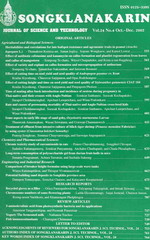ThaiScience
ThaiScience
SONGKLANAKARIN JOURNAL OF SCIENCE & TECHNOLOGY
Volume 42, No. 02, Month MARCH, Year 2020, Pages 454 - 460
Carboxymethyl cellulose from rice stubble waste
Pattrathip Rodsamran and Rungsinee Sothornvit
Abstract Download PDF
Rice stubble is an agricultural waste with 30.67% yield of cellulose (90.05% α-cellulose content) to be synthesized as carboxymethyl cellulose (CMC). Hemicellulose and lignin were first removed and later rice stubble cellulose was swollen in 30% NaOH and isopropanol as a solvent. Synthesis conditions such as chloroacetic acid content (5–7 g in 5 g of alkali cellulose), reaction temperature (50 and 70 C) and time (180, 270 and 360 min) were investigated to obtain CMC from rice stubble (CMCr). The 7 g of chloroacetic acid at 50C for 180 min provided the best quality of CMCr based on 5 g of rice stubble cellulose with degree of substitution, viscosity and purity of 0.64, 36.03 cP and 90.18%, respectively. The presence of carboxymethyl substituents was verified by Fourier transform infrared spectroscopy. CMCr showed commercially low viscosity material and possibly used as a film forming packaging material for food and pharmaceutical products.
Keywords
rice stubble, waste, carboxymethyl cellulose, degree of substitution, puritySONGKLANAKARIN JOURNAL OF SCIENCE & TECHNOLOGY
Published by : Prince of Songkla University
Contributions welcome at : http://rdo.psu.ac.th
